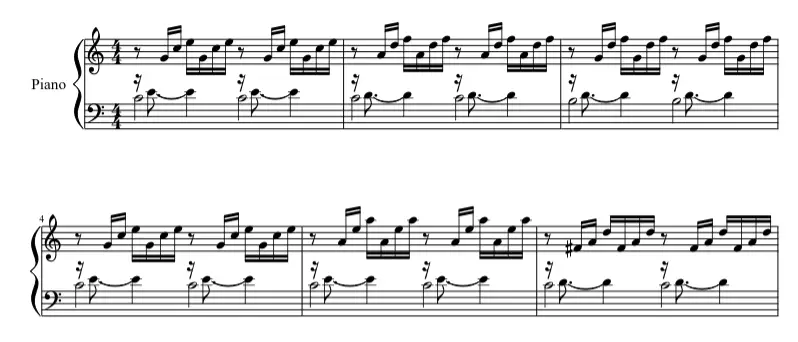This post contains affiliate links.

Prelude in C Major is one of Bach’s most well-known pieces and you want to learn how to play it. However, you aren’t sure how easy or hard the piece is and whether or not you’re ready to play it.
Prelude in C Major is easy if you’ve been learning the piano for at least 1-2 years. For a complete beginner, the piece has many new concepts and will be time-consuming to learn all at once but is doable as the techniques needed to properly play the piece aren’t difficult.
In this article, I’ll talk about the difficult parts that I noticed when I played this piece and whether the piece is easy enough for you to play.
I’ll also give some tips on playing the piece and a rough estimate of how long it will take for you to learn the piece in its entirety.
Wonder about the ABRSM/RCM level of this piece? I also talk about it at the bottom of the article
Is Prelude in C Major easy?
For complete beginners
For a beginner, the piece will be hard because of all the new concepts a beginner needs to learn:
- Know all the notes in treble and bass clefs
- Understand different note values: whole notes, half notes, quarter notes, eighth notes and sixteenth notes.
- Dotted notes and how to count them
- Eighth and sixteenth rest
- Ties vs slurs
- Accidentals that determine which notes to sharpen or flatten
- Fermata which tells you to hold a note longer than its indicated value
- Different dynamics throughout the piece
Learning a lot of new concepts at once may be too much and can discourage a beginner from practicing the piece more. It’ll be better for a beginner to learn new concepts one by one by playing easier pieces first or going through children’s workbooks.
However, if the piano teacher’s goal is to introduce multiple concepts at once in one piece and deems their student to be able to handle it, then Prelude in C Major is the perfect piece to do so.
With that said, if you are a beginner and are willing to put in the hours and effort to learn the concepts you haven’t seen before and practice, you can play this piece because aside from the new concepts, this piece doesn’t require crazy hand techniques to play it.
For people with more experience playing the piano
If you’ve been playing the piano for at least 1-2 years, Prelude in C Major will be easy for you to learn.
The pieces consist of broken chords that repeat 4 times in every measure for the right hand and the same simple rhythm throughout the piece. If you can play the first 4 measures, you can play the rest of the piece because those first 4 measures are duplicated 8 times but with different notes.
Although the sixteenth notes seem intimidating, you can always practice at a slower tempo with both hands to get it right before speeding up. Also, the fact that your right hand only needs to play sixteenth notes throughout the whole piece makes them less scary.
You’ll need to use the sustain pedal to play the piece. You’ll reset and step on the pedal again with every new measure.
Furthermore, for people that have difficulty playing the piano with both hands, this piece is a great practice exercise because the left hand only needs to play 2 notes for each measure (thanks to the tie), except for the last 3 measures.

I’ve also heard of many advanced players using this piece as a sight-reading exercise or can play this piece after spending a couple of hours or a day at most practicing it. So the more experience you have playing the piano, the easier this piece will be for you.
Fun fact: Prelude in C Major fits perfectly on 61-keys for anyone with a 61-keys keyboard.
Are there any hard elements in Prelude in C Major?
Playing the notes evenly
Because each broken chord repeats 4 times in every measure, it’s difficult to play all the notes evenly at an equal length of sixteenth notes since your hand is repeating the same sequence of notes.
Also, it’s easier for the audience to notice the sequence of notes being played unevenly if the sequence is repeated multiple times. Accidentally hold a note for a millisecond more and the piece will sound uneven.
When I practiced the piece, there are moments where my fingers either slip or hesitate for a millisecond as I was remembering what notes to play next and that millisecond creates an uneven sound that was very noticeable.
Maintain equal volume for all notes in a broken chord
Aside from holding the notes at an equal length to their written values, within each broken chord, you need to press each note with an equal force so the volume is the same throughout. It’s very easy to accidentally put more emphasis on the uppermost note of the broken chord.
While playing the piece, I tried playing the uppermost note of the chord a bit louder than the rest as an experiment in a different interpretation of the piece, and find that it sounds better to play the notes at an equal volume.
Ritardando ending
If you listen to recordings of the piece, you’ll notice the piece ends by gradually slowing down to its last chord. This is called ritardando and can take a couple of attempts to make the slowing down sounds gradual and not suddenly.

Dynamics
Dynamics are symbols under a measure that tells you how loudly or softly to play that passage. These are the common dynamics you may see:
- p: play softly
- f: play loudly
- pp: very soft
- ff: very loud
- mp: moderately soft
- mf: moderately loud
If you don’t have much experience with dynamics, you may find it difficult to switch volumes when getting into a new passage that has one of those symbols. This is because you need proficient control of your fingers that comes with experience to switch between different flavours of playing softly or loudly

How long does it take to learn Prelude in C Major?
If you have experience playing piano, you can spend as soon as 2 weeks learning the notes and playing at tempo. However, it could take you another week of practice to be able to play evenly since that’s the hardest aspect of the piece.
If you’re a beginner then you need at least 2 months to be able to play since you need to learn and apply all the new concepts. This is assuming that you’re spending 30 minutes at least every day practicing the piece.
However, this is a rough estimate and the amount of time needed to learn Prelude in C Major varies based on the person. Some people are more talented than others and will be able to learn the piece more quickly.
Or that person A may have difficulty learning one aspect of the piece while person B understand that aspect easily as it comes naturally to them.
For example, when I learned the piece, I find transitioning into a new broken chord in every new measure to be challenging, especially when done at a fast tempo. Thus, I spent a lot of time practicing that aspect of the piece, whereas another person may not have the same problem I had.
Tips to make learning Prelude in C Major easier
Practice broken chords as block chords
When you first start learning the piece, instead of repeating a broken chord four times for every measure, play all the notes in a broken chord at once. So every measure for the right hand you need to play only one block chord.
This is to familiarize yourself with all the notes in the chords throughout the piece while saving time since you aren’t playing each chord four times.
Then omit the repeating broken chord
Once you’re familiarized with all the notes, it’s time to practice broken chords as the piece intended.
When combined with the left hand, every measure has two sequences of notes and broken chords that are the same. You can cut practicing time in half by omitting the repeating sequence and focusing more on the hand shift between different broken chords in different measures.
Practice at a slow tempo
It’s easy to be tempted to practice this piece at the tempo recommended. However, it’s more efficient to slow down and practice at a slower tempo first since you’ll be able to go through the entire piece more quickly that way. If you can play a piece slowly, you can play that piece quickly.
Use a metronome
One of the hardest parts of playing Prelude in C Major is playing all the notes evenly because if you don’t play evenly, you’ll immediately notice the uneven sound and sense the hesitation within it.
This is where a metronome comes in handy: set the metronome to the recommended tempo of the piece and follow and play along to the beats. This will help you play evenly without much concentration and eventually, you’ll be able to play without a metronome.
For which type of metronome to use, a metronome app that you can download from the App Store or Google Play is good enough for the job.
If you want to go with a physical metronome, get a digital metronome since you need to put a traditional mechanical metronome on an even surface, or else the beats will be off.

You can get a digital metronome here on Amazon (affiliate link). This one is small enough to fit in your jeans pocket, simple and gets the job done.
Or if you like the looks of a traditional metronome to go with your piano, have a look at this Donner metronome on Amazon (affiliate link). Donner is a well-known company with quality music products.
Alternatively, you can get a digital metronome shaped like a traditional metronome to get the best of both worlds! (affiliate link)
What piano grade is Prelude in C Major?
Prelude in C Major will be ABRSM grade 3 in terms of techniques. However, to be able to play the piece musically (with expression), the piece will be a grade 5. This would translate to a level 5-6 in the RCM exam system.
Note that Prelude in C Major has never appeared on either the ABRSM or RCM syllabus. But comparing to pieces within grade 5 of ABRSM, Prelude in C Major has a similar difficulty to them.
And since any particular grade in ABRSM is considered harder than the RCM level with the same number (for example ABRSM grade 8 is harder than RCM level 8), Prelude in C Major is estimated to be RCM level 5-6.

